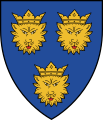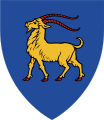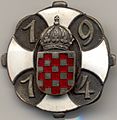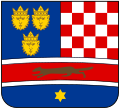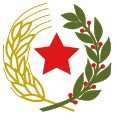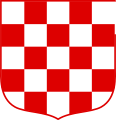Coat of arms of Croatia facts for kids
Quick facts for kids Coat of arms of Croatia |
|
|---|---|
 |
|
| Armiger | Republic of Croatia |
| Adopted | 21 December 1990 |
| Crest | A crown of five arms, as follows: Bleu Celeste a mullet of six points Or above a crescent argent; Azure two bars gules; Bleu Celeste three leopard heads caboshed Or; Azure a goat statant Or unguled and armed gules; Bleu Celeste on a fess gules fimbriated argent a marten Sable courant proper in chief a mullet of six points Or |
| Blazon | Chequy of twenty-five gules and argent |
The coat of arms of the Republic of Croatia (Croatian: Grb Republike Hrvatske) is a special symbol for the country. It has one main shield and five smaller shields. These five smaller shields form a crown above the main shield.
The main part of the coat of arms is a checkerboard pattern. It has 13 red squares and 12 white squares. People in Croatia often call it šahovnica (pronounced shah-ho-vnee-tsa). This means "chessboard" in Croatian. The five smaller shields on top show symbols from different historical regions of Croatia.
Contents
What the Coat of Arms Looks Like
The Croatian coat of arms is shaped like a shield. It has 25 red and white squares. The first square in the top left corner is red.
Above this main shield is a crown. This crown has five points or "spikes." Inside the crown are five smaller shields. Each of these smaller shields shows a historical symbol from a part of Croatia. They are lined up from left to right in this order:
- The oldest known Croatian symbol
- The symbol of the Dubrovnik Republic
- The symbol of Dalmatia
- The symbol of Istria
- The symbol of Slavonia
History of the Croatian Coat of Arms
The checkerboard pattern, or šahovnica, has been a symbol of Croatia for a long time. It first appeared as an official symbol of the Kingdom of Croatia in 1495. You can see it on a tower in Innsbruck, Austria, from that time. It also appeared on a seal in 1527. This seal confirmed Ferdinand I, Archduke of Austria as the king of Croatia.
Some people believe this checkerboard design is even older. A tradition says it was used by Stephen Držislav in the 10th century. Old stone carvings from the 11th century also show patterns that look like the checkerboard.
The number of squares in the checkerboard has changed over time. It has been 3x3 squares up to 8x8 squares. But most often, it has been 5x5 squares, just like the one used today.
Over the centuries, the šahovnica became a widely recognized symbol for Croats and Croatia. In 1919, it was included in the coat of arms of the Kingdom of Yugoslavia. This was to represent the Croats living there.
During World War II, a government in Croatia added their own symbol, the letter "U," to the šahovnica. After the war, when Croatia became part of a socialist country, the šahovnica was still used. But it was part of a new design that included symbols like wheat, an anvil, a rising sun, and a red star. These symbols represented workers and a new beginning.
When Croatia became independent in 1990, the country decided on a new design. They removed the socialist symbols. For a short time, there was a version where the first square was white. But on December 21, 1990, the current design was officially adopted. This design has the first square in the top left corner as red.
The Current Design
The current coat of arms was designed by the artist Miroslav Šutej. It was officially adopted on December 21, 1990.
The new design added the five smaller shields to the crown. These shields represent different historical regions of Croatia. Let's look at what each one means:
|
This is thought to be the oldest known symbol for Croatia. It shows a golden six-pointed star above a silver crescent moon on a blue shield. The star represents the morning star (Venus). You can find this symbol on old Croatian coins from the 12th century. |
|
|
This shield represents the Dubrovnik region. It has two red stripes on a dark blue shield. This is a simpler version of the old Coat of arms of Dubrovnik. The original coat of arms was given to Dubrovnik by King Louis I in 1358. |
|
|
This shield represents Dalmatia. It shows three golden lion heads with crowns on a blue shield. These lion heads are facing forward. This symbol has been used since at least the 14th century. It was also used to represent Croatia in general for a long time. |
|
|
This shield represents Istria. It has a golden goat with red hooves and horns on a dark blue shield. The goat has been a symbol of Istria for a very long time. This coat of arms became official in 1861. |
|
|
This shield represents Slavonia. It shows a six-pointed star above two silver stripes on a blue shield. Between the stripes, there is a running marten (a small animal) on a red field. The two silver stripes represent the rivers Drava and Sava. These rivers mark the northern and southern borders of Slavonia. The marten is important because the Croatian money, the Croatian kuna, is named after it. This symbol comes from old coins minted between 1235 and 1384. |
The Croatian coat of arms is often used in many designs. For example, you can see it on the planes of Croatia Airlines or on the jerseys of the Croatia national football team. This is because its checkerboard design is very recognizable and works well in different places.
Historical versions of the crown arms
The coats of arms used in the crown on the modern-day coat of arms are slightly different from older historical versions.
-
Coat of arms of Istria
Gallery
-
.
Coat of arms of Croatia used in 1527 as part of a seal on the Cetingrad Charter
-
Kingdom of Croatia-Slavonia (1868–1918). The official version had St. Stephen's crown due to Croatia being part of Lands of the Crown of Saint Stephen.
-
Common coat of arms of Austria-Hungary (1915–1918)
-
Kingdom of Yugoslavia (1918–1941)
See also
 In Spanish: Escudo de Croacia para niños
In Spanish: Escudo de Croacia para niños









